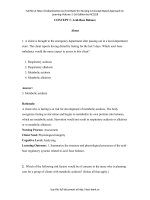Ancient philosophy a new history of western philosophy volume 1 (new history of western philosophy) ( PDFDrive ) 196
Bạn đang xem bản rút gọn của tài liệu. Xem và tải ngay bản đầy đủ của tài liệu tại đây (20.72 KB, 1 trang )
EPISTEMOLOGY
Academic Scepticism
It is not surprising that Stoic epistemology should be challenged from
a sceptical angle. It was surprising, however, that the challenge should
come from the Academy, from the heirs of Plato. Surely the Platonic
corpus contains some of the most dogmatic philosophy ever to be devised.
The leaders of the later Academy, however, Arcesilaus and his successor,
Carneades, traced their ancestry further back. They appealed to Socrates,
whose question and answer technique so famously punctured false claims
to knowledge (Cicero, Fin. 2. 2). Socrates himself claimed no philosophical
knowledge, and left no philosophical writings; and Arcesilaus and
Carneades followed him in both respects. But they went further
than Socrates in commending a much more radical scepticism: a suspension of belief not only on philosophical but also on the most everyday
topics.
Though Arcesilaus and Carneades left no writings, we are reasonably
well informed about their philosophical teachings because Cicero, who had
been taught by Carneades’ pupil Philo, was much attracted to Academic
Scepticism, and left a lively account of the to and fro of sceptical debate in
his Academica. From him and other sources we learn that the Academics
presented a battery of arguments to show that there could be no infallible
impressions.
There is no true impression arising from sensation that cannot be paired
with another impression, indistinguishable from it, which is non-cognitive.
But if two impressions are indistinguishable, it cannot be the case that one
of them is cognitive and the other not. Therefore no impression, even if
true, is cognitive. To illustrate this argument, consider the case of identical
twins, Publius Geminus and Quintus Geminus. If someone looking at
Publius thinks he is looking at Quintus, he has an impression that corresponds in every detail to the one he would have if he were in fact looking at
Quintus. Hence, his impression is not a cognitive one: it does not answer to
the Wnal clause of Zeno’s deWnition: ‘of such a kind as could not arise from
what is not’ (Cicero, Acad. 2. 83–5).
In reply, the Stoics seem to have denied the possibility of any pair of
objects resembling each other in every respect. They propounded the thesis
later known as the identity of indiscernibles: no two grains of sand, no two
wisps of hair, were totally alike. The Academics complained that the thesis
173









